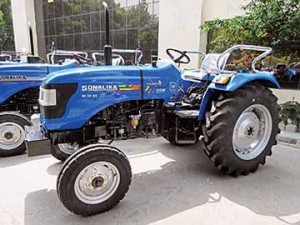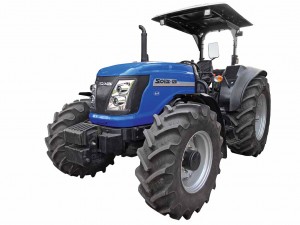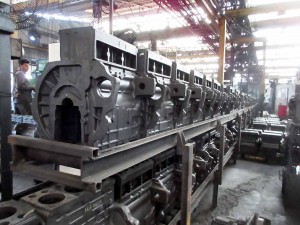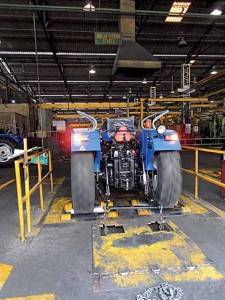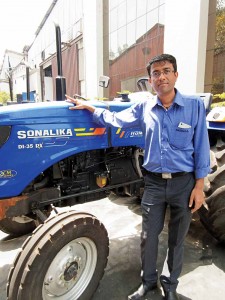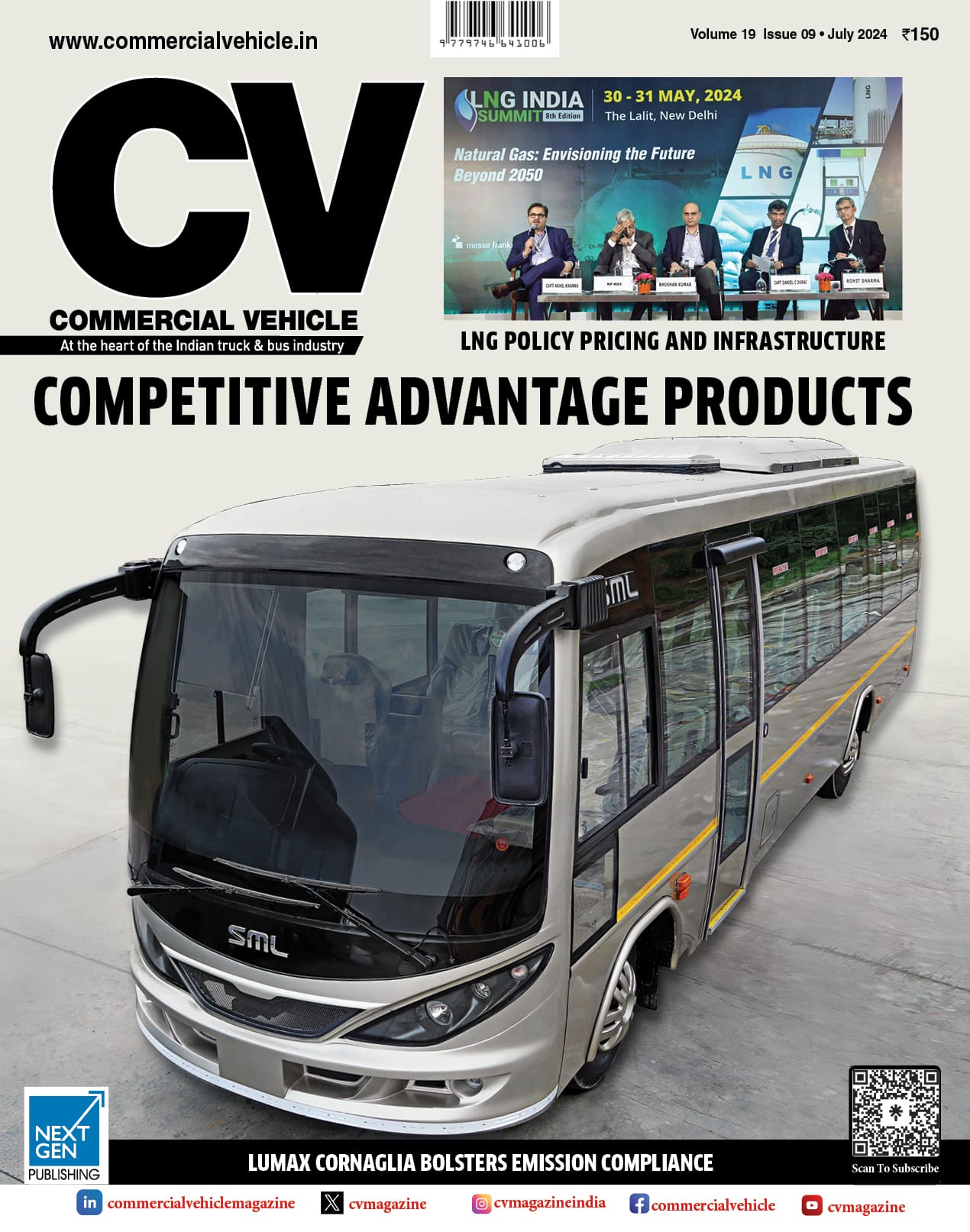International Tractors is banking on growth by providing ergonomically advanced products that best suit the needs of the farmers.
Story by:
Anirudh Raheja
International Tractors Limited (ITL), which manufactures and markets Sonalika brand of tractors, reported a robust 19.6 per cent increase in sales at 81531 units in FY2016-17, the highest sale of tractors to be ever recorded in the history of the company. In comparison, tractor sales in India grew 18 per cent in FY2016-17, recording a sale of 582844 units according to the Tractor Manufacturers Association. In FY2015-16, 493764 tractors were sold. Increasing the market share from 11.9 per cent to 12.3 per cent, domestic sales of ITL grew 18 per cent, at 69290 units. Exports registered a growth of 29.3 per cent at 12241 units in last fiscal. Bullish about growth, and keen to provide ergonomically advanced products (tractors) that best suit the needs of farmers, ITL has commissioned a fully integrated tractor plant at Hoshiarpur, Punjab. Spread over an area of 85 acres, the new plant is located adjacent to the existing plant. With a capacity to produce two lakh tractors per annum, the new plant will elevate the total manufacturing capacity of ITL to three-lakh units. The existing plant has the capacity to make one-lakh tractors per annum. Fueled by an investment of Rs.800 crores, the new plant is fully equipped to roll out tractors ranging from 20 hp to 120 hp in a takt time of two minutes. Engineered to produce tractors up to 180 hp according to Amrit Singh Mittal, Vice Chairman, ITL, the new plant will support the company’s move to higher capacity tractors, and exports. “Ninety-nine per cent of the tractors sold in India may amount to a power output of less than 60 hp, we are confident that the tractor industry will soon graduate to higher hp engines,” he said. Stressing upon a modern approach, Mittal averred that mechanisation in agriculture is rising. On the account of exports, claimed a source close to the company, that plans are being drawn to export one-lakh tractors. These would be produced at the old plant.
Tracing its roots to 1969 when it manufactured its first farm equipment (thresher), ITL in an effort to enhance its technical capabilities entered into a joint venture with Renault Agriculture, France, and Class Tractors, Germany, in 2000. This was 14 years after ITL produced the first tractor in 1996. The company began producing engines in-house in 2001. By 2005, the company grew up to become the fourth largest manufacturer of tractors in India. It tied up with Japanese diesel engine specialist Yanmar. The new plant, by leveraging technology, and the experience the company has gained over the years, will contribute to the endeavour to produce a good number of aggregates in-house. Aggregates like engine, chassis, sheet metal parts, differential and transmission.
Operations
The new plant will hike ITL’s capacity to produce tractors to 300 from the current capacity to produce 225 tractors per shift. ITL at present runs two eight-hour shifts. When the demand increases, a shift is extended to 10-12 hours, said Mittal. In an effort maintain a competitive edge in what is termed as the biggest tractor market in the world, third shift is also pressed into service if the need arises. ITL manufactures an entire range of engines – from 20 hp to 110 hp, at the plant. The engine plant has an installed capacity of 500 engines per day, and has been engineered such that it will play an importat role in ITL’s endeavour to develop engines of different capacities. There are 24 engine test beds. With the current emission compliance standards for tractors being BSIIIA, ITL’s Sonalika brand of tractors have been affected with the Supreme Court order to stop sale as well as the register BSIII vehicles from April 01, 2017. In many parts of India. RTOs not wanting to attract contempt of court, are said to refuse registration of tractors that complying with BSIIIA emission regulations. This is despite the emission standards for tractors being different from what the trucks and buses follow. Informed Raman Mittal, Executive Director, ITL, that the (tractor manufacturers) association is making the required presentations, and is hoping that business is not significantly affected.
Producing two, three and four cylinder engines, in naturally aspirated and common rail turbo-diesel guise, the engine plant of ITL has over 23 production stages. Particular attention is paid to the quality of manufacture from the initial stage. Averred Amrit Singh Mittal, “India is a price sensitive market. It is important therefore that we develop fuel efficient products.” Post deregulation, price of diesel has been rising. In the wake of that, the company is working on a completely new series of tractors that are stylish, ergonomically sorted and comfortable. ITL, in a bid to address the exacting needs of the Indian market, developed a 35 hp DI35Rx Sikander tractor recently. Powering the tractor is a three-cylinder unit that generates a torque of 157 Nm peak torque. Transmission is a constant mesh design with six forward and six reverse gears. For superior fuel efficiency, the hydraulic pump of the tractor can be disengaged from the engine when not in use. “This reflects on our understanding of the Indian market,” quipped Mittal. He pointed at the four tractors his company launched in October last year. “These tractors have beeen designed and engineered for potato farming, and are equipped with adjustable track width, a hydraulic system that was specially developed, and have a compact turning radius to help them maneouvre in the field without damaging the crop,” opined Mittal. Pramod Rajan, Head, R&D, ITL, expressed, “We are developing a six-cylinder 120hp engine for tractors. Production of this engine will begin later this year. The engine will find application in big tractors the company exports. The 120 hp engine platform will be leveraged to produce higher capacity engines mentioned Rajan. A 200 hp engine is on the anvil too. If this will provide a glimpse of ITL’s plans for the future, the 120 hp tractor, informed Rajan, will be equipped with a 24+24 transmission, and offer a massive 4,500 kg lifting capacity. Of the opinion that a tractor should transform into a status symbol, Rajan revealed that engines above 50 hp are being equipped with common-rail technology. The change in emission standards for engine above 50 hp is said to be a reason for this. The other is perhaps, the rising sale of tractors in the 40 to 50 hp range. In the last five years, most tractors sold in India are in the 40 to 50 hp range.
Tractor transmission
If the engine assembly makes for an interesting insight at the ITL plant, the transmission line adds to the knowledge of tractor manufacture. Found on the line are transmission cases, gears, shafts, clutch plates, and more. Multi-speed transmissions are produced with a 12+12 speed range. To maintain consistency, the company manufactures four wheel drive axles in-house. Stating that the shift to 50-60 hp tractors in India is likely to happen faster than expected, Rajan revealed that they are working on an eight forward and two reverse speed transmission. It will be upgraded to 12 forward and 12 reverse gearbox, and introduced in the 60 hp segment followed by the 40-50 hp segment as well. ITL is also working on 30 hp tractors with hydrostatic transmission. The company plans to export them to Europe and US.
For tractors to withstand tough working conditions, ITL’s gear shop manufactures between 250 and 400 different components. The facility has a capacity to manufacture 1.5 million parts per annum. A total of 112 machines including 22 gear hobbing machines and 12 gear shaving machines have been installed. Also, a part are a Seal Quench Furnace (SQF), induction hardening and pit type furnace. A modern metallurgical lab has been set up. It contains Leco Spectrometer and a Micro Hardness Tester from USA among other test equipment. A Japanese spectrometer is used to ensure the quality of spur, bevel and helical gears is right.
R&D and manufacturing
Employing 200 engineers and 100 technicians, ITL R&D is at the core of numerous initiatives the company is taking. Out of the 200 engineers, 120 engineers are engaged in design projects that will materialise in the future. They are closely supported by 50 product testing engineers. Crucial to the smooth functioning of the world’s largest integrated tractor manufacturing plant with world-class technologies, ITL R&D, according to Rajan, is playing an important role in the design and development of aggregates. The cathodic electro-coating pre-treatment facility has a dip tank of 70,000 litre capacity. The paint shop technology ensures up to 95 per cent paint utilisation, and is manned by six robots. While the sheet metal parts are produced at the press shop, most plastic parts are also made in-house. The company has 26 machines including 19 presses of up to 400 tonne capacity; two laser machines (sourced from Prima, Italy), and three injection moulding machines. To manufacture in-house dies for press tools, sheet metal parts and injection modules, 35 machines work in tandem. The desired level of accuracy is maintained by ITL with 167 special purpose machines and 57 CNC machining centers sourced from Mazak, Japan. To achieve a competitive takt time, castings at the plant are transferred through under pit conveyors. The final assembly line is structured such that every unit undergoes a number of tests. These include a roller test, hydraulic test and a vibration test. To ensure optimal product quality, the company employs quality management systems like Pokayoke.
Exporting tractors to 80 countries, ITL is developing products that will comply with the stage IV emission norms. These would be aimed primarily at the export markets of Europe and US. ITL is also working on telematics. Testing of a telematics platform, according to Rajan, is on. The results will determine the time to market. Rajan is of the opinion that it will still take some time before the tractor market warms up to the prospect of using telematics. Costs, he said, are a barrier. Looking at expanding its reach in the domestic, and overseas markets, ITL is banking on ergonomically advanced, robust and efficient tractors. Apart from an assembly unit in Cameroon, Africa, the company is setting up a unit in China. A cost sensitive market according to Raman Mittal, the unit at China – expected to be operational at the end of this fiscal – will open up new avenues for the company. With Yanmar agreeing to buy Blackstone Equity Investors’ shares in ITL for Rs.1,600 crores, Yanmar’s holding in the company is set to rise to 30 per cent. This is expected to boost outsourcing. Mittal is keen to see his company export one lakh units. “Out of the one lakh units, 50,000 units will be manufactured for our partner Yanmar’s outsourcing commitments. The remaining 50,000 will be sold independently under the Sonalika brand,” said Mittal.
Pramod Rajan, Head, Research and Development, International Tractors Limited
Q. What role is the R&D playing in the company’s growth?
A. We have a team of 200 engineers and 100 technicians. Of these, there are 120 design engineers. Supporting them are 50 engineers that carry out testing. Playing an important role, the R&D carries out numerous tasks including design, development, and testing. For example, work is being carried out on a 120 hp engine that will go into production later this year. In India, BS IIIA emission norms apply to agricultural products. So, we are working on the engine for it to meet these norms, and offer superior efficiency. The R&D plays an important role in the design and development of aggregates. With aggregate manufacture and assembly carried out in one plant, we also play a role in developing skin panels. Final processing of 50 per cent parts is done in-house. It is the child parts that are procured from outside.
Q. What new projects are you working on?
A. We are currently focusing on two things – fuel efficiency and performance. We want to improve the fuel efficiency of our product portfolio. Diesel prices have started moving north. Indian customers are very price sensitive, and it is therefore essential that we offer fuel efficient products. Our products are known to be robust, stylish and comfortable. We want to ensure that our products exceed their requirements. With rural markets warming up to new things, expectations are rising. This is making it necessary that we look at styling and comfort in the case of tractors. We will soon launch a completely new series of tractors for the domestic market. These will highlight comfort and styling. We feel that the tractor should be a status symbol.
Q. What role is the R&D playing in exports?
A. We export tractors to Europe and US. For these markets we developed StageIV compliant engines that will go into production in the last quarter of this fiscal. In India, we believe that BSIV emission norms for tractors will come only in 2020. The cost of technology at this point will be very high. We expect an emission norms shift in the category above 50 hp.
Q. How soon could telematics become a standard fitment on tractors?
A. We have already put telematics systems on our test tractors. We have the system ready for customers, and offer to those who demand it. We have not marketed it because cost of having a telematics system is high. The perceived value for customer is not high. It may be not be a standard fitment solution for now therefore, and will be offered only on demand. It is true that the competition is already offering telematics systems on their machines. The cost of telematics, in India, is still on the higher side. Telematics is used by fleet operators. For an individual owner to use a mobile phone makes more sense since it is cheaper. Owning a phone costs no more than Rs.200. Servicing a telematics system every month will cost more that Rs.500 per month. Customer therefore is still reluctant to pay.
Q. What new could ITL offer next year?
A. One of the plan is to shift tractors in the 60 to 120 hp range to common-rail technology. The 120 hp tractor is equipped with a six-cylinder engine. It is aimed at the African market where the land size is huge. This engine can be elevated to produce 200 hp. As per the demand, we will slowly move forward. In India, where the land mass is not as big. We will go up to 75 and 90 hp tractors at the most. For special applications, some government tenders are calling for 100 and 110 hp machines. These would be used for clearing snow, and will account for a very small volume. We do not produce hydrostatic transmissions for India. For Europe and US, we are looking at hydrostatic transmission for less than 30 hp. This transmission could be aimed at the hobby farming segment.
Q. Which do you think are the fast emerging segments in India?
A. In the last five years, the maximum tractors that are being sold are in the range of 40 to 50 hp. In 2011, there was an emission norms change for tractors above 50hp. As far as the tractor industry is concerned, a shift is likely to take place from 40 to 50 hp, and to 50-60 hp. A shift beyond that looks difficult. Tractors in the 40-50 hp range account for 30 per cent of the market. We are currently selling eight forward and two reverse speed transmissions. We are working on 12 forward and 12 reverse gears transmission. This will be offered on 60 hp machines, and later on in the 40-50 hp segment tractors.
Q. Does the rising use of plastics in tractors hint at the need to light weight?
A. There is a requirement for light weighting of tractors. Especially in the rice producing belts in South India. We will introduce products in that segment with our partner Yanmar in the 40-50 hp segment.




